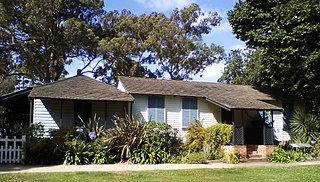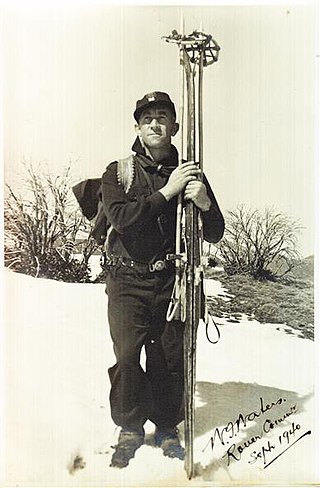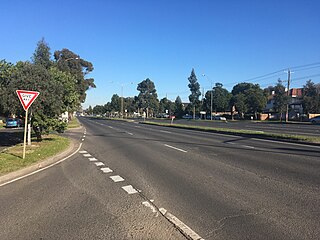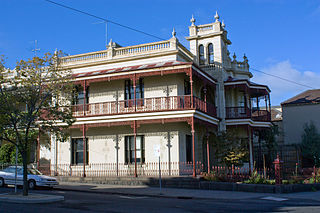
The Victorian Artists Society, which can trace its establishment to 1856 in Melbourne, promotes artistic education, art classes and gallery hire exhibition in Australia. It was formed in March 1888 when the Victorian Academy of Arts and the Australian Artists' Association amalgamated.

Parliament House is the meeting place of the Parliament of Victoria, one of the parliaments of the Australian states and territories.

The Queen Victoria Market is a major landmark in the central business district (CBD) of Melbourne, Victoria, Australia. Covering over seven hectares, it is the largest open air market in the Southern Hemisphere.

La Trobe's Cottage is a historic cottage in Melbourne, Victoria, Australia, built in 1839 by the first superintendent of the Port Phillip District of New South Wales, Charles La Trobe, and his family.

A coffee palace was an often large and elaborate residential hotel that did not serve alcohol, most of which were built in Australia in the late 19th century.

The Hawthorn Bridge crosses the Yarra River, five kilometres (3.1 mi) east of Melbourne, Victoria, Australia, connecting Bridge Road and Burwood Road. It is the oldest extant bridge over the Yarra River and is one of the oldest metal bridges in Australia. It was constructed in the early wave of major new infrastructure funded by the Victorian gold rush. Designed by Francis Bell, it is a substantial riveted, wrought iron, lattice truss structure, with bluestone abutments and piers.
Bates Smart is an architectural firm with studios in Melbourne and Sydney, Australia. Founded in 1853 by Joseph Reed, it is one of Australia's oldest architectural firms. Over the decades, the firm's practices involving architecture, interior design, urban design, strategy, sustainability and research, have been responsible for some of Australia’s most recognizable buildings.

William Francis "Bill" Waters was Scouts Victoria's Headquarters Commissioner for Rover Scouts between 1930 and 1965.

Old Princes Highway is a collection of roads, described as any part of an earlier route designated as Princes Highway, located in Victoria, Australia. Sections of the road run through Geelong, Werribee, and through the outer fringes of south-eastern Melbourne eventually to Morwell East. In the time since their de-listing as Princes Highway, many former sections have since been renamed, or have devolved to their original names.

Percy Edgar Everett,, was appointed chief architect of the Victorian Public Works Department in 1934 and is best known for the striking Modernist / Art Deco schools, hospitals, court houses, office buildings and technical colleges the department produced over the next 20 years.
Robert Guyon Whittlesey Purchas was an Australian architect, especially noted as a pioneer of the Arts & Crafts style seen in a number of large residential projects in the late 1890s and early 1900s. He was the son of prominent architect, civil engineer, and surveyor, Albert Purchas.

George Cornwell was a British railway engineer and building contractor working in Melbourne, Victoria, Australia in the second half of the nineteenth century. Among his prominent works, were the Hawthorn Railway Bridge built in 1861, with a span of about 60 metres (200 ft), being one of the last major items of permanent way to be completed on the fledgling Melbourne and Suburban Railway. Under the name 'George Cornwell and Co.' Cornwell had previously been involved as contractor in many other major construction works including the Melbourne Grammar School, the Model School, Coppin's Haymarket Theatre, the Sunbury railway goods shed and other Melbourne and Suburban Railway works. Subsequently, he was a contractor on Parliament House, Albert Park Station, Jack's Magazine and the Wallaby Creek water supply.

The architecture of Melbourne, the capital of the state of Victoria and second most populous city in Australia, is characterised by a wide variety of styles in various structures dating from the early years of European settlement to the present day. The city is particularly noted for its mix of Victorian architecture and contemporary buildings, with 74 skyscrapers in the city centre, the most of any city in the Southern Hemisphere.

Wardlow is an Australian house of historical significance located in the Melbourne suburb of Parkville. It was built in 1888 by John Boyes and is considered to be a fine example of the boom style Italianate architecture of that time, and is listed by the Victorian National Trust.

Royal Parade is a major urban road in Victoria, Australia, linking Melbourne City to Brunswick and the northern suburbs. It is the site of major educational and sporting facilities as well as several buildings of heritage significance.

The Old Physics Conference Room and Gallery is a university teaching and art gallery located at 156-292 Grattan Street, The University of Melbourne, Parkville Campus, Melbourne, Victoria, Australia.
William Charles Welsh was an Australian rules footballer who played with Collingwood in the Victorian Football League (VFL). He was the father of Hawthorn and Richmond player Peter Welsh.
Godfrey and Spowers, now Spowers, is an Australian architectural design firm established about 1901 century in Melbourne, specializing in commercial and institutional buildings since the 1920s.

Ralph Curtis Shalless was a former Australian rules footballer who played with Melbourne and Hawthorn in the Victorian Football League (VFL).
Claude Fay Felstead was an Australian amateur golfer. He won the 1909 Australian Open and was runner-up in the 1911 Australian Amateur.















